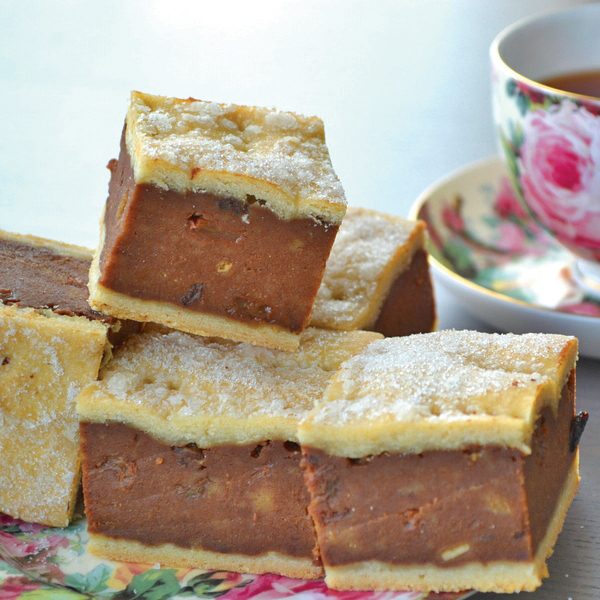
Above: Image of gur cake courtesy of Caitríona Redmond’s food blog wholesome.ie
Today it is hard for us to imagine what life was like in 1916. Now we take for granted the variety of food that is on offer and a walk around Dublin can allow us to taste the cuisine of many different cultures from around the world.
The ordinary Jackeen in 1916 derived nutrition from a limited group of traditional staples. Remembering that it was war time with rationing in place, a ‘waste not want not’ approach was adhered to. The pig was eaten top to tail (apart from the grunt) and provided the basis for what is probably the best-known Dublin dish, coddle.
Boiling and frying were the cooking methods of choice and another favourite was cabbage and bacon, with the salty bacon providing much-needed seasoning for the soggy green vegetable. These ingredients, together with what is by far the most Irish of foodstuffs, the ‘spud’, could be heard in the street rhymes of Dublin children through the ages – “yum yum, pig’s bum, cabbage and potatoes” (pronounced ‘badaadas’).
It was not all gruel and gur cake, however. Edwardian Dublin played host to an influx of culinary excellence and the 1911 census showed a large number of highly-skilled chefs residing and working in the most prestigious Dublin Hotels and they introduced affluent Dublin to Haute Cuisine.
These hotels were not immune from the outside world, though, and menus from Sheldon carried a government warning noting that only 5oz. of meat (uncooked weight), 2 oz of bread, and 2/7 oz sugar were allowed per meal. Customers were allowed to bring their own meat and have it cooked.
One award-winning and highly respected chef from this time was the Belgian-born Zenon Geldof, grandfather of ‘Sir Bob’. He was head chef of Jury’s in College Green during the 1916 Rising, he experienced bullets flying through his kitchen and needed a specific permit to allow him home from work at night.
The Easter Rising in 1916 led to the devastation of many premises, including the Metropole and Hamman Hotels in Sackville Street. The Metropole was re-built as a Ballroom, Cinema and Restaurant in 1922. The hotels and restaurants of Edwardian Dublin were among the finest in the British Isles, with the standard of fine dining fit for the highest echelons of the aristocratic establishment.
For this special issue of the culinary corner we could sample haute cuisine from one of the period’s top hotels but we think it would be more fitting to have some lovely Gur Cake that can be used for dessert.
Gur Cake Recipe
This tasty sweet cake is also a native of Dublin and keeps with the wasteless tradition of using up leftovers. Apparently, it got its name from the times when the ‘gurriers’ of the Dublin tenements would collect the waste breadcrumbs and fruit from the floor of the bakeries and bring the scraps home to mammy who turned it into the fruit slice that soon became known as ‘gur cake’ as homage to the gurriers themselves.
Ingredients
280g shortcrust pastry
350g leftover cake or bread
60g (½ cup) unsifted self raising white flour
90g (½ cup) brown sugar, firmly packed
1 large egg, beaten to mix with 1-2 teaspoons mixed spice (nutmeg, cinnamon and ginger)
60-175g (¼ to ¾ cup) mixed dried fruit
Strongly brewed tea
Method
Steep the fruit in the tea overnight or for at least an hour.
Place the leftover cake/ bread in a food processor and whiz until you have crumbs. Stir in the rest of the dry ingredients. Add the steeped fruit along with the beaten egg. You may add some milk or water if you feel more moisture is needed to achieve a stiff, paste like texture.
Grease a rectangular 11×7 inch cake tin. Roll out the pastry thinly into two pieces the size of the tin. Line the bottom of the tin with one layer of pastry. Spread the filling on top. Cover with the second layer of pastry. Prick the top with a fork, then brush with a little milk.
Bake at 190ºC, Gas Mark 5, for 45 minutes or until crisp and golden brown. Cool in cake tin.
Gur cake is cut into rectangular chunks.
The very nature of this cake meant that the ingredients altered each day according to what what left over in the bakery. Experiment using treacle instead of brown sugar; add the zest of citrus fruits or even a drop of brandy. Anything goes.
Enjoy with a mug of strong tea and don’t forget to give a nod to the Dublin of 1916 when gur cake was the cake of kings.
By Maria Shields O’Kelly



